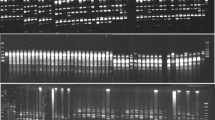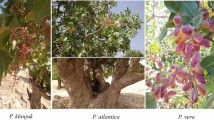Abstract
We used Randomly Amplified Polymorphic DNA (RAPD) markers to examine patterns of relatedness among 29 pistachio (Pistacia vera L.) cultivars and accessions. These included 13 cultivars that we had previously described, and an additional 16 items from the USDA National Clonal Germplasm Repository/Davis comprising cultivars and land races originating further east of the cultivars described previously, and material from wild P. vera stands in or near the putative center of origin for pistachio in South Central Asia. The results show high levels of polymorphism in the species emphasizing the importance of preservation of the remaining wild stands of P. vera. Analyses support the concept that cultivars in use west of the Zagros-Caucasus ranges likely originate from a limited germplasm base. The newly examined cultivated material shows greater genetic diversity, consistent with the hypothesis that pistachio cultivation originated in or near South Central Asia. Results also indicate that for at least two cases, material identified differently in two collections are the same clones, thus illustrating the value of molecular marker techniques in describing and maintaining germplasm collections for clonally propagated species.
Résumé
En este trabajo se ha empleado la técnica del ADN polimórfico amplificado al azar (RAPD) para examinar la similitud genética entre 29 cultivares y accesiones de pistachero (Pistacia vera L). Este material incluye 13 cultivares considerados en un trabajo anterior y 16 nuevas accesiones del Banco Nacional de Germoplasma Clonal del USDA en Davis que incluyen cultivares y razas locales de regiones más orientales que las consideradas anteriormente así como material procedente de basques naturales de P. vera situados en las proximidades del presunto centro de origen del pistachero. Los resultados obtenidos muestran un alto grado de polimorfismo, lo que indica la necesidad de conservar el germoplasma de P. vera todavía existente en estado natural. Además se confirma la hipótesis de que los cultivares procedentes del oeste de la zona Caucásica y del Zagros se originaron a partir de una base genética limitada. El nuevo material estudiado muestra una mayor diversidad genética lo que corrobora la idea de que el cultivo del pistachero se inició en Asia Central. Al menos en dos de los casos estudiados, el material identificado en dos colecciones diferentes como distintos genotipos, en realidad se trata del mismo clon, lo que demuestra la utilidad de los marcadores moleculares en la descripción y mantenimiento de colecciones de germoplasma en especies de reproducción vegetativa.
Similar content being viewed by others
Literature Cited
Bachmann, K. 1994. Molecular markers in plant ecology. The New Phytologist 126:403–418.
Bretting, P. K., and M. P. Widriechner. 1995. Genetic markers and plant genetic resource management. Plant Breeding Reviews 13:11–86.
Fabbri, A., J. I. Hormaza, and V. S. Polito. 1995. Random amplified polymorphic DNA analysis of olive(Olea europaea L.) cultivars. Journal of the American Society for Horticultural Science 120: 538–542.
Hormaza, J. I., L. Dollo, and V. S. Polito. 1994. Determination of relatedness and geographical movements ofPistacia vera L. (pistachio; Anacardiaceae) germplasm by RAPD analysis. Economic Botany 48:349–358.
Lamboy, W. F. 1994. Computing genetic similarity coefficients from RAPD data: the effects of PCR artifacts. PCR Methods and Applications 4:31–37.
Linchevskii, I. A. 1974. Anacardiaceae. Pages 395–411 U. Plitman Ed., Flora of the U.S.S.R. vol 14. Israel Program for Scientific Translations, Keter Publishing House, Jerusalem. Translation of a work published in Russian by the Botanical Institute of the Academy of Sciences of the U.S.S.R. in 1949.
Lowe, A. J., O. Hanotte, and L. Guarino. 1996. Standardization of molecular genetic techniques for the characterization of germplasm collections: the case of random amplified polymorphic DNA (RAPD). Plant Genetic Resources Newsletter 107: 50–54.
Newbury, H. J., and B. V. Ford-Lloyd. 1993. The use of RAPD for assessing variation in plants. Plant Growth Regulation 12:43–51.
Nicese, F. P., J. I. Hormaza, and G. H. McGranahan. 1997. Molecular characterization and genetic relatedness among walnut (Juglans regiaL.) genotypes based on RAPD markers. Journal of the American Society for Horticultural Science (In Press).
Olekhnovich, G. S. 1989. BreedingPistacia vera in Tadzhikistan. Sostoyanie i perspektivy razvitiya promyshlennogo orekhovodstva, 6–8 sentyabrya. Tezisy dokladov Vsesoyuznogo soveshchaniya, 14-15.
Popov, K. P. 1994. Trees, shrubs, and semishrubs in the mountains of Turkmenistan. Pages 173–186in V. Fet and K. I. Atamuradov, eds., Biogeography and ecology of Turkmenistan. Kluwer Academic Publishers, Dordrecht, the Netherlands.
Rieseberg, L. H. 1996. Homology among RAPD fragments in interspecific comparisons. Molecular Ecology 5:99–105.
Warburton, M. L. and F. A. Bliss. 1996. Genetic diversity in peach(Prunus persica L. Batch) revealed by randomly amplified polymorphic DNA (RAPD) markers and compared to inbreeding coefficients. J. Amer. Soc. Hortic. Sci 121:1012–1019.
Weising, K., H. Nybom, K. Wolff, and W. Meyer. 1995. DNA fingerprinting in plants and fungi. CRC Press, Boca Raton.
Whitehouse, W. E. 1957. The pistachio nut—a new crop for the Western United States. Economic Botany 11:281–321.
Williams, J. G. K., A. R. Kubelik, K. J. Livak, J. A. Rafalski, and S. V. Tingey. 1990. DNA polymorphisms amplified by arbitrary primers are useful as genetic markers. Nucleic Acids Research 18: 6531–6535.
Zlotin, R. I. 1994. Ecosystem structure of subtropical arid pistachio woodlands in southern Turkmenistan. Pages 187–196in V. Fet and K.I. Atamuradov, eds., Biogeography and ecology of Turkmenistan. Kluwer Acadmec Publishers, Dordrecht, the Netherlands.
Zohary, M. 1952. A monographical study of the genusPistacia. Palestine Journal of Botany (Jerusalem Series) 5:187–228.
Zohary, M. 1973. Geobotanical foundations of the Middle East. Gustav Fischer Verlag, Stuttgart.
Author information
Authors and Affiliations
Rights and permissions
About this article
Cite this article
Hormaza, J.I., Plnney, K. & Polito, V.S. Genetic diversity of Pistachio (Pistacia vera, Anacardiaceae) Germplasm based on Randomly Amplified Polymorphic DNA (RAPD) markers. Econ Bot 52, 78–87 (1998). https://doi.org/10.1007/BF02861298
Received:
Accepted:
Issue Date:
DOI: https://doi.org/10.1007/BF02861298




